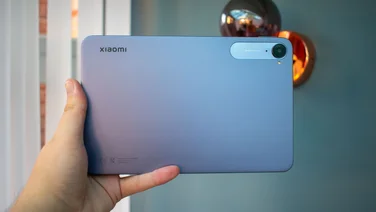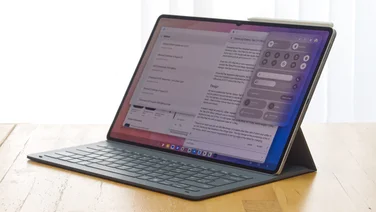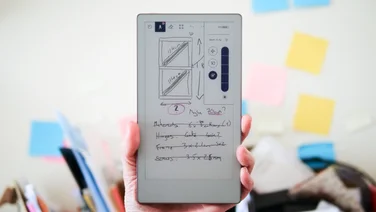To help us provide you with free impartial advice, we may earn a commission if you buy through links on our site. Learn more
- Samsung Galaxy Tab S9 Ultra review: What you need to know
- Samsung Galaxy Tab S9 review: Price and competition
- Samsung Galaxy Tab S9 Ultra review: Design
- Samsung Galaxy Tab S9 Ultra review: Software
- Samsung Galaxy Tab S9 Ultra review: Display
- Samsung Galaxy Tab S9 Ultra review: Performance
- Samsung Galaxy Tab S9 Ultra review: Verdict





- Very slim and light
- Big, beautiful AMOLED display
- Decent battery life
- Multi monitor support is awkward
- Software can be niggly
Premium tablets like the Samsung Galaxy Tab S9 Ultra (and its smaller brethren) can be a bit of a tricky sell. Manufacturers are selling them both as top-end tablets and productivity devices that can replace a laptop for work.
And yet, with prices as high, if not higher, than established ultra portable laptops such as the MacBook Air or the Samsung Galaxy Book Pro, you have to be pretty confident you can do what you need to with a productivity tablet before shelling out.
It’s certainly possible. I‘ve used an M2 iPad Pro as my main laptop for on-the-go computing for some time now and, with a few minor reservations, I’m happy with it as a laptop alternative. The question is, can the same be said for the best Android productivity tablet around – the Samsung Galaxy Tab S9?
READ NEXT: These are the best tablets you can buy right now
Samsung Galaxy Tab S9 Ultra review: What you need to know
With the Tab S9’s predecessor, I wasn’t entirely convinced and this year, it doesn’t look like much has changed. It’s still a beautiful piece of hardware with its large 14.6in AMOLED screen and it seems almost impossibly slim and light. However, software niggles and irritations hold it back from true greatness.
Still, this is undoubtedly the best Android tablet money can buy. Inside, it’s as powerful as can be, with an enhanced for Samsung Qualcomm Snapdragon 8 Gen 2 chip inside and 12GB or 16GB of RAM, depending on the storage option you choose. Those storage options run from 256GB all the way up to 1TB.
You can also get the tablet with 5G for an extra fee and all of Samsung’s new tablets come with an S Pen active stylus in the box. Alas, as with most other productivity tablets you do have to pay extra for the keyboard case, which seems a bit mean with prices this high, but Samsung is at least giving its customers a choice between a premium folio case, which comes with a touchpad, and a cheaper one that doesn’t.
Samsung Galaxy Tab S9 review: Price and competition
The Samsung Galaxy Tab S9 Ultra is the most expensive tablet in Samsung’s tablet line up with prices starting at £1,199 for the model with 12GB of RAM and 256GB of storage, jumpingto £1,299 with 512GB of storage and topping out at £1,549 if you want 16GB of RAM and 1TB of storage. Adding 5G connectivity adds another £150 to the price but I can’t see the point of that when tethering is so simple and straightforward.
With a screen this large, there aren’t any direct rivals so you have to look down the size scale for alternatives. The most obvious is the 12.9in M2 Apple iPad Pro, which to my mind is the ultimate in productivity tablets yet it still has its irritations. The file system can be very irritating to use at times, and with its Magic Keyboard folio case attached, it’s actually surprisingly heavy. However, it’s superbly powerful and with Apple’s excellent range of tablet-focused apps, there’s very little you can’t do with an iPad these days.
Like the Tab S9 Ultra, prices for the 12.9in M2 iPad Pro are far from cheap. In fact, believe it or not, they start £50 (£1,249) more expensive than the Galaxy Tab S9 Ultra for a model with half the storage (128GB). If you want the equivalent M2 iPad Pro, you’ll be paying £1,369 and, remember, that’s without a stylus. The Apple Pencil adds another £139, making the 12.9in iPad Pro effectively £309 more expensive than the Tab S9 Ultra.
If you’re completely sold on the tablet-with-detachable keyboard formula but don’t have faith that you can do everything you need to do with iPadOS or Android, then your best bet is the Microsoft Surface Pro 9, which costs from £1,099 and runs Windows 11. That’s for the Intel Core i5 model with 256GB of storage and no stylus. Add the Surface Slim Pen 2 stylus and the price goes up to £1,219. Purchasing that tablet with the stylus and keyboard bundle will set you back £1,359.

Despite initial impressions, then, the Tab S9 Ultra is actually pretty good value – and if you order a Galaxy Tab S9 Ultra before 5 September on the Samsung website, it’s even better as you’ll get the basic keyboard case for free.
Samsung Galaxy Tab S9 Ultra review: Design
To be honest, if you buy the Tab S9 Ultra with the keyboard case, you won’t be exposed to its gloriously slender chassis all that much. And that would be a shame because it’s utterly gorgeous – a tablet that’s beautifully put together.
It measures 5.5mm from its front glass to its sheer aluminium rear and it’s a featherweight, too. Pop the Tab S9 Ultra on the scales and it reads 732g (737g for the 5G model). The 12.9in iPad Pro is lighter but it’s also significantly smaller.

The screen at the front fills most of the chassis with a narrow border surrounding it on all sides, and there’s a small bathtub notch housing the twin front-facing 12MP cameras – one wide angle for group video calls, the other a standard angle webcam. Both deliver exceptionally clear, well balanced images.
At the rear is another pair of cameras in the top-left corner and a magnetic strip for charging the bundled S Pen. Around the edges, you’ll find the power and volume buttons on the top long edge, a USB-C port on the right short edge and four speaker grilles for the quad-speaker system firing left and right.
None of this should come as a surprise to anyone familiar with last year’s Tab S8 Ultra, which had the same proportions and overall design. The only notable physical differences between the Tab S9 and its predecessor are that the camera housings are in a slightly different position, meaning you can’t use the keyboard case from last year because the holes don’t line up. The tablets all have IP68 dust and water resistance ratings this year, too. I can’t imagine ever feeling I had to use such a large tablet in wet or dusty conditions but it’s nice to have peace of mind either way.

What I can’t tell you is whether or not the keyboard folio case has been improved this year as Samsung has yet to supply a sample for testing. I did have the opportunity to briefly try the non-touchpad keyboard at the launch event and that seemed to work well but I’ll confirm that if I get the chance to try it out properly. However, with this in mind, and the fact that I wasn’t impressed at all with the touchpad on the premium keyboard last year, my initial suggestion would be to opt for the cheaper basic keyboard case.
Fortunately, the stylus works brilliantly. The S Pen’s nib gives just enough friction on the screen to give it a nice feel on the screen – it’s certainly more pleasant to sketch and jot notes with than the £139 Apple Pencil, which has a hard plastic nib – and both responsiveness and pressure sensitivity is impressive. Still, digital artists may want to wait a while for the forthcoming S Pen Creator stylus, which will have enhanced tilt detection and multiple nibs. You’ll have to pay extra for that, though.
READ NEXT: The best 2-in-1 laptops to buy today
Samsung Galaxy Tab S9 Ultra review: Software
As this is a premium Android tablet, it won’t surprise you to hear that the Samsung Galaxy Tab S9 Ultra runs the latest version of Android 13 at the time of writing. This is overlaid with Samsung’s OneUI version 5.1.1 which, most interestingly for this particular tablet, comes with the option of running Samsung’s DeX desktop user interface.
This can be launched manually by tapping the DeX button in the Android notification shade or automatically by connecting the tablet to an external monitor. Essentially, it reformats Android into a desktop style environment more suitable for operation using a keyboard and mouse. It allows you, among other things, to run your Android applications in resizable windows or in split screen. Most settings and app shortcuts, likewise, are moved into a taskbar at the bottom of the screen.
And, among a series of subtle changes, for this generation of tablets Samsung has introduced the ability to control a paired Samsung phone with your mouse, including the ability to drag and drop files and images between devices. This works well (although it’s a bit fiddly to set up) but it’s a little gimmicky in my view when you can simply pick up your phone and use it, as intended, via its touchscreen and send files back and forth via Samsung’s Airdrop equivalent: Nearby Send.

As is usual with these sorts of products I do make the effort to use them to do actual work in an effort to discover if they represent a realistic laptop alternative and, so far, so good. I’ve written the entirety of this review in Google Docs, updated Google Sheets spreadsheets in the browser and joined in several video call meetings in Google Meet and Microsoft Teams without an issue.
As with every “laptop alternative” style device there is a period of adjustment to go through and some annoyances, which I’ll go through below but largely, I’d say I’ve been impressed. The performance is decent – I’ve never been left waiting around for an app to launch – and the tablet hasn’t exhibited any serious slow down, despite multiple apps running in the background and loads of tabs open in the browser.

The speakers are decent, too – not quite as full and warm as on the 12.9in iPad Pro, but loud enough to listen to podcasts and talk radio without recourse to headphones. It’s a similar story with the microphones; they pick up your voice clearly, lending it clarity and body – perfect for video calls and voice note recordings.
Where the Tab S9 Ultra falls short is in the proliferation of minor irritations and restrictions that prevent you from going about your business in a completely seamless fashion. Some of these issues are operating system related, of course. For example, I found that sometimes clicking on an app in the taskbar would sometimes fail to launch the app in question, although I would always be able to switch to it by Alt-Tabbing or using the recent apps menu. I don’t particularly like that clicking the app drawer button results in a full-screen, Windows 8-style takeover, either, and quite why you can’t reverse the direction on a mouse scroll wheel is anybody’s guess.

It’s also worth noting that DeX still doesn’t support multi-monitor setups properly. Hook it up to an external monitor and the DeX desktop environment will display fine on that screen (although only up to 1,920 x 1,080 resolution). If you do this, however, the display on the tablet reverts to the touchscreen Android environment and can’t be controlled with the mouse. This is just plain weird.
Other annoyances relate to Android apps simply not exhibiting desktop-appropriate behaviour. The address bar in Chrome, for instance, has this annoying quirk that means you can’t edit addresses once you’ve loaded a page. Instead, when you click on the address in an attempt to edit it, the text disappears and you have to type it in manually or search for the page via Google.
I found another small but annoying “feature” in Google Docs whereby holding backspace for a few seconds too long would result in whole chunks of sentences disappearing. And the YouTube app would stop playing in the background whenever I ran another app in full-screen mode.
None of these are deal breakers in their own right and they won’t stop you using the tablet for work or enjoyment but, added up, they do contribute to a considerably more niggly experience than using an iPad Pro for the same sort of jobs.
Samsung Galaxy Tab S9 Ultra review: Display
Of course, you may be willing to forgive all of these foibles once you clap eyes on the Samsung Galaxy Tab S9 Ultra’s utterly gorgeous screen. Apart from being pretty large, measuring a massive 14.6in across the diagonal, it looks incredible, too. It uses Samsung’s Dynamic AMOLED 2X technology – the same as on the company’s smartphones and Galaxy Book 3 Pro laptops – and it performs just as well here.

In the settings you have two choices of colour mode: Vivid, which reproduces an impressive 116.6% of the DCI-P3 colour gamut, and Natural, which delivers 101.7% of the sRGB gamut. Colour accuracy in the Natural mode is pretty decent, too, with an average Delta E of 1.09 versus sRGB and peak brightness in HDR playback reaches a blindingly bright 961cd/m2.
In short, it’s a stunning display that’s perfect for watching HDR streaming content and it looks glorious on supporting services: video on YouTube, Prime Video and Netflix all look incredible. Unfortunately, not every service takes full advantage and notably neither Disney Plus nor BBC iPlayer going beyond Full HD or offering HDR playback. That’s disappointing (but not without precedent) although it must be said that the AMOLED screen is so good that even non 4K HDR content still looks pretty amazing.
READ NEXT: The best 2-in-1 laptops to buy today
Samsung Galaxy Tab S9 Ultra review: Performance
The Samsung Galaxy Tab S9 Ultra is powered by a specially tweaked “Made for Samsung” version of Qualcomm’s Snapdragon 8 Gen 2 chipset. This is an octa-core part with a slightly higher-than-stock top frequency of 3.36GHz (vs 3.2GHz for the regular 8 Gen 2) but otherwise has all the same features as other devices running the standard chipset.
It’s manufactured using a 4nm wafer and has three different types of CPU core: one performance core running at up to 3.36GHz and two slower cores running at up to 2.8GHz (both for 64-bit apps only), another pair of 2.8GHz cores that can also run 32-bit apps, plus a further three efficiency cores for background and low-power tasks that run at up to 2GHz.
All this delivers performance that is, fairly predictably, a notch quicker than last year’s tablet (which ran the older 8 Gen 1 chipset) and a good deal slower than the M2 Apple iPad Pro.


What’s more impressive, perhaps, is that, despite the increase in speed, the new tablet delivers better battery life than last year’s model, lasting 12hrs 51mins in our video playback test. In fact, the Samsung Galaxy Tab S9 Ultra not only outstrips its predecessor for stamina, it is also an iPad Pro beater in this regard, lasting a full hour and a half longer in our video playback test.

Samsung Galaxy Tab S9 Ultra review: Verdict
The Samsung Galaxy Tab S9 Ultra is a brilliant piece of hardware, of that there is no doubt. It’s achingly slim, battery life is great, the screen is a thing of beauty and performance is fast enough to dispatch most tasks with consummate ease. If you are simply looking for the very best tablet money can buy, then this is a very good choice.
The thing is, I said the same thing about last year’s model. The key for productivity tablets like this is the software and, on that front, the Samsung Galaxy Tab S9 Ultra still feels a bit like a work in progress.
Still, it is considerably cheaper than the comparatively smaller iPad Pro so, if you’re prepared to put up with a few quirks, its big screen and bundled stylus makes the Tab S9 Ultra a very decent Android-based choice.







